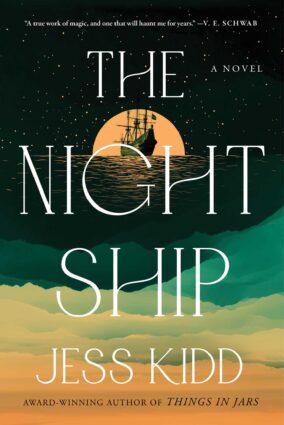
“As is the way with souls confined, tempers fray and flare, ill-spoken words fester, coincidences become intrigues. Minds seethe with resentment and revenge like the worms in the water barrels. As the ship spoils, so does the air between the people.”― Jess Kidd, The Night Ship.
1629: nine-year-old Mayken leaves the Netherlands with her nursemaid to join the merchant father she’s never met across the globe in the Dutch East Indies on the Batavia, one of the greatest ships of the Dutch Golden Age. Curious and mischievous, Mayken begins a secret, second life as the cabin boy Obbe, befriending a soldier, a sailor, a kitchen boy, and the ship’s barber-surgeon while trying to hunt down the eel-like monster Bullebak purported to live belowdecks.
1989: A lonely boy named Gil, also nine, is sent to live with his cantankerous grandfather on Beacon Island off the coast of Western Australia among the seasonal fishing community where his late mother once lived. This is where the Batavia sank, and an archeological excavation of the wreck is now underway. The project intrigues Gil, as does the rumor that a ghost haunts the island.
The Night Ship is based on a true story that I found far more interesting than the novel. I went down a long bunny trail on this one:
On the morning of June 4, 1629, the Dutch East India flagship Batavia wrecked on Morning Reef off Beacon Island with 341 people aboard. Approximately 100 people died in the immediate aftermath. The following morning 180 people—among them 30 women and children—were ferried two kilometers to the island.
After an extensive search for fresh water, Commander Francisco Pelsaert sailed with his senior officers to Batavia (modern-day Jakarta) to find help. Pelsaert left his deputy, Jeronimus Cornelisz in charge, who, unbeknownst to Pelsaert, had been plotting a mutiny prior to the wreck.
Cornelisz became a brutal dictator. He rationed food and confiscated all weapons. Any rafts made by survivors also had to be relinquished. He divided the population into smaller groups and spread them among the nearby islands, many under the pretense of searching for fresh water and abandoned to death. He then orchestrated a massacre that, over several weeks, resulted in the murder of approximately 125 of the remaining survivors, including women, children, and infants. The marauders cut people’s throats at night and took others out to drown on makeshift rafts. They kept some women as sex slaves.
It took three months for Pelsaert to return from Batavia with the rescue party. He took the worst of the mutineers to Seal Island and punished them—executioners cut off their right hands before hanging the men. Cornelisz lost both hands before his hanging on October 2, 1629.
After it was all over and they had executed all mutineers, only 116 Batavia survivors remained.
Although the intricately plotted parallel narratives worked, and the book had plenty of drama, this was a tough read for me. There was some witty writing in the 1989 timeline, but the pacing was slow, and the chapters were too short, making the writing seem disjointed. Mayken and Gil were motherless, which was already sad. Add an epidemic of dysentery, primitive medical care, rape, and murder, and you have a melancholy, disturbing novel. The Night Ship has a fascinating premise based on a historical event, but I never connected with the characters and found the plot too grim. 3 stars.
If you’d like to read more about this historical shipwreck, follow this link. https://www.sea.museum/2016/06/04/barbarism-and-brutality-surviving-the-batavia-shipwreck
*Thanks to the NetGalley and the Publisher for a copy of this book. The opinions expressed here are my own.
